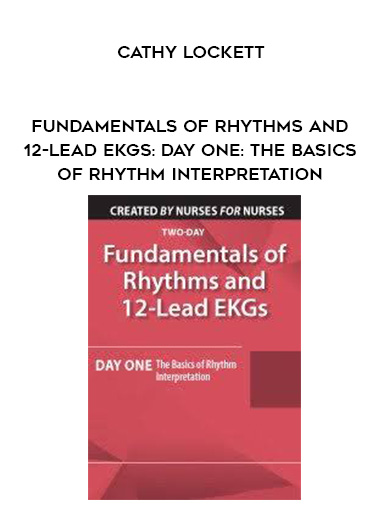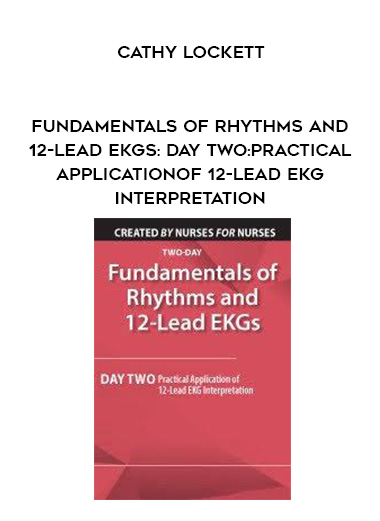FUNDAMENTALS OF RHYTHMS AND 12-LEAD EKGS: DAY ONE: THE BASICS OF RHYTHM INTERPRETATION – CATHY LOCKETT
It’s two o’clock on a Sunday morning and you are the Charge Nurse on a 24-bed telemetry/Med Surg Unit. Mrs. J, in room # 312, is on telemetry and her low heart rate monitor alarm goes off.
You assess her and note she is hemodynamically compromised with a BP of 74/42, cool and clammy skin and complaints of dizziness. What is the rhythm strip telling us about the patient? Do you know what do next?
Know what clues to look for and what steps to take by attending this information-packed seminar. Leave with a clear understanding of and be able to recognize basic and advanced cardiac dysrhythmias. Learn the systematic approach to EKG interpretation, with advanced skills in differentiating ischemia from infarct on the EKG, identifying STEMI imposters and many other causes of abnormal EKGs. Use these skills to improve patient outcomes for patients like Mrs. J and others you see in practice by being able to anticipate treatments and complications.
Objectives
- Relate coronary artery perfusion to cardiac musculature and the conduction system.
- Utilize a nine-step systematic approach to interpret EKGs.
- Discuss the basic electrophysiology of the heart: Electrical versus mechanical function.
- Discuss and review bedside monitoring leads and EKGs to include 12-lead, posterior leads and right-sided.
- Identify the types of bradycardias and heart blocks and state treatment modalities.
- Determine the appropriate clinical management of the various patient problems encountered.
Outline
Fundamentals of Rhythm Interpretation Cardiac Conduction System Electrical Activity Action Potential
- Depolarization and Repolarization
- Correlation of waveforms
- Calculating rate and measurement of intervals
Monitoring Leads and Associated Anatomy: From Bedside Monitoring to Twelve-Lead EKG
- 3-lead telemetry
- 5-lead telemetry
- 6-lead telemetry
EKG Interpretation
- Frontal plane limb leads
- Horizontal plane chest leads
- Importance of the positive electrode
- Rule of electrical flow
- Layout of the 12-Lead EKG/ 15-Lead EKG/R-sided EKG
- Utilize a systematic approach: Rhythm/Rate/Axis interpretation/ Examination of waveforms
Coronary Artery Perfusion
- Relate coronary perfusion to cardiac musculature and the conduction system
Cardiac Monitoring: The Best Leads for Waveform and Arrhythmia Detection
- QT Monitoring
- ST segment/ T wave observation for ischemia/ infarct/abnormal repolarization
- Arrhythmia detection
Mechanical Activity: Is there a Pulse?
- Contraction
- Cardiac Output
- Compensatory Mechanisms
- Pulseless electrical activity
- Asystole
Rhythm Review: Differentiating Stable from Unstable Rhythms Bradycardic Rhythms: Observe and monitor or treat
- Sinus Bradycardia
- Sinus Arrest / Sinus Pause
- Sick Sinus Syndrome
- Escape Rhythms
- AV Heart Blocks
- First Degree
- Second degree type 1 and 2
- Complete heart block
Tachycardic Rhythms
- Sinus Tachycardia: Determine the cause
Pathophysiology of Supraventricular Arrhythmias: AV nodal reentry or enhanced automaticity
- Atrial tachycardias
- Atrial Fibrillation
- Atrial Flutter
- Junctional tachycardia
Ventricular dysrhythmias: Perfusing or not Perfusing?
- PVCs
- Monomorphic ventricular tachycardia
- Polymorphic ventricular tachycardia
- Torsades de Points
- Ventricular fibrillation
Tag: Fundamentals of Rhythms and 12-Lead EKGs: Day One: The Basics of Rhythm Interpretation – Cathy Lockett Review. Fundamentals of Rhythms and 12-Lead EKGs: Day One: The Basics of Rhythm Interpretation – Cathy Lockett download. Fundamentals of Rhythms and 12-Lead EKGs: Day One: The Basics of Rhythm Interpretation – Cathy Lockett discount.






